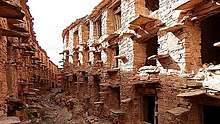Agadir (granary)
An agadir (Berber languages: ⴰⴳⴰⴷⵉⵔ, plural: igudar or iguidar, "the wall" or "the fortified compound") is a fortified communal granary found in the Maghreb.[1][2] Some of these date back to the 10th century.[3] These structures are typically composed of a granary and a citadel, and are located in rocky, elevated locations to protect surrounding farms and livestock from enemies.[3] In addition to harvested grains, Amazigh communities inhabiting the mountainous south of Morocco would use these structures to store all kinds of valuable belongings, including deeds and records, money, jewelry, clothing, carpets, and sometimes clothes and munitions.[4]
Name
The term agadir is Amazigh, borrowed from (Phoenician: 𐤀𐤂𐤃𐤓, ʾGDR)[5] meaning "the wall", "the compound", or (by metonymy) "the stronghold".[6] The word agadir is common in North African place names, such as Agadir, Morocco, and the cities Cádiz and Gedera are also etymologically related.[5] The word al-Makhzen (المخزن), used to refer to the Moroccan state apparatus, also means storehouse, but in Arabic.[4]
.jpg) The Ikounka Agadir.
The Ikounka Agadir. The Sidi Moussa Agadir of Ait Bougoumez.
The Sidi Moussa Agadir of Ait Bougoumez. The Inoumar Agadir in the Souss-Massa region.
The Inoumar Agadir in the Souss-Massa region.- The Id Aissa Agadir near Amtoudi.
References
- "Greniers collectifs - Patrimoine de l'Anti Atlas au Maroc | Holidway Maroc". Holidway (in French). 2017-02-28. Retrieved 2020-04-06.
- "Collective Granaries, Morocco". Global Heritage Fund. Retrieved 2020-04-06.
- Raffaelli, Giuliana; Robles Marín, Pedro; Guerrera, Francesco; Martín Martín, Manuel; Alcalá-García, Francisco Javier; Amadori, Maria Letizia; Asebriy, Lahcen; El Amrani, Iz-Edine; Tejera de León, Julian (June 2016). "Archaeometric study of a typical medieval fortified granary (Amtoudi Agadir, Anti-Atlas Chain, southern Morocco): a key case for the maintenance and restoration of historical monuments". Italian Journal of Geosciences. 135 (2): 280–299. doi:10.3301/IJG.2015.25. hdl:10045/64989.
- "L'agadir, ancêtre du Makhzen marocain?". Zamane (in French). 2018-06-12. Retrieved 2020-04-06.
- Lipiński, Edward (2002). Semitic Languages: Outline of a Comparative Grammar. Orientalia Lovaniensia Analecta. 80. Belgium: Peeters Leeuven (published 2001). p. 575. ISBN 978-90-429-0815-4.
- "Phoenician and Punic Inscriptions", p. 141. Journal of the Royal Asiatic Society of Great Britain and Ireland. Accessed 24 July 2013.